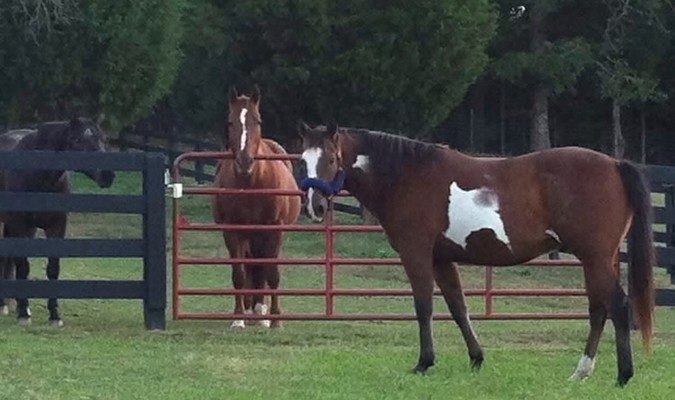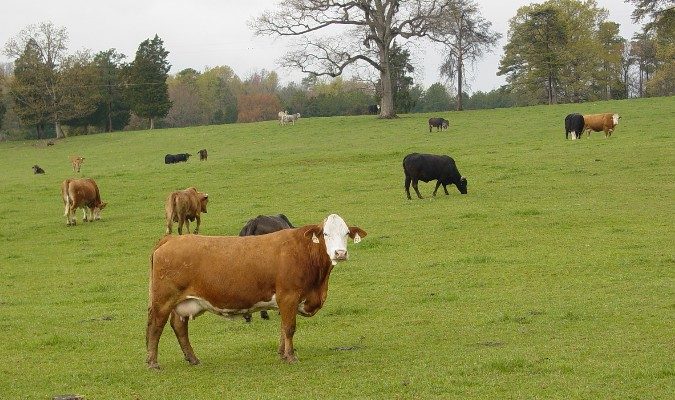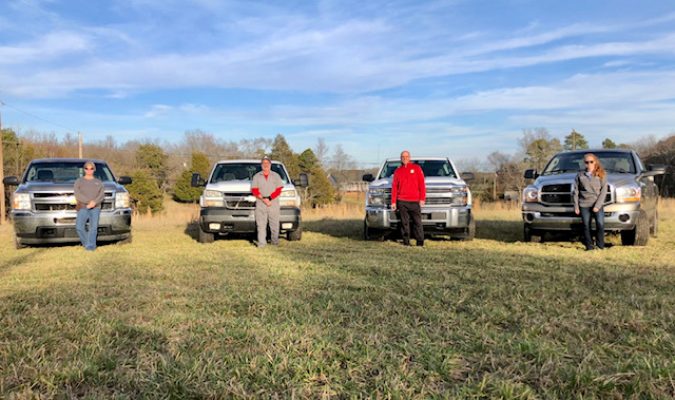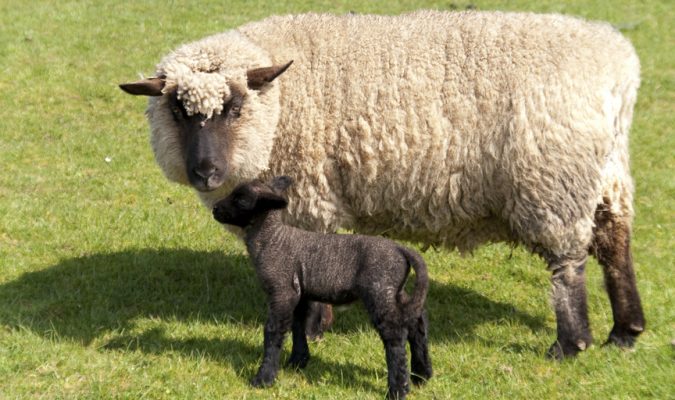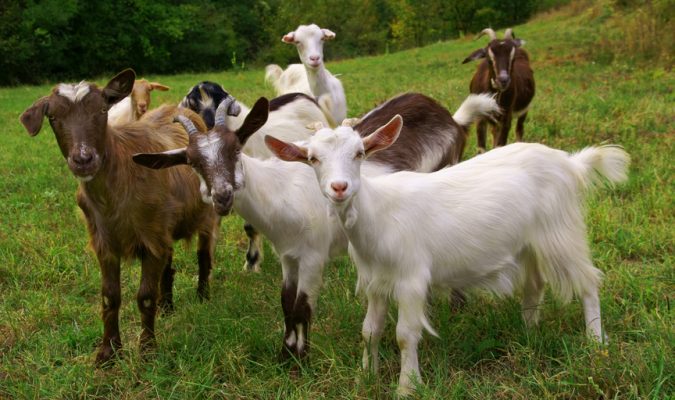This month’s newsletter will focus on helping our cattle producers understand the utility of vaccines, diseases worth protecting their herd against, and best vaccine handling strategies. This newsletter in particular isn’t focused on developing herd vaccination strategies, but we hope to put together a guideline for producers to use in the future.
Breakdown of Cattle Vaccines
- Purpose of Vaccination: The general idea behind vaccination is to safely stimulate the immune system against a particular virus or bacteria by introducing a weakened or killed pathogen to the animal. The animal then mounts an immune response and is able to defend itself against the disease for a certain amount of time depending on the specific pathogen and type of vaccine.
- Types Of Vaccines:
- Modified Live Vaccine: The pathogens in this type of vaccine have had their virulence reduced but not completely eliminated meaning they still have the potential to reproduce. This allows for a stronger and longer lasting immunity for the cow similar to a true infection, and there is the unlikely potential for the pathogen to cause disease in immunocompromised animals.
- Killed/Inactivated Vaccine: The pathogens in this type of vaccine are killed through heat or chemicals to eliminate risk of causing disease. When injected with the killed vaccine, the proteins or components of the pathogen are presented to the cow’s immune system to generate an antibody response.
- Where To Vaccinate: Different vaccines require different routes of administration, and so it’s important to always read the label prior to using them. When using injectable vaccines, in order to comply with the meat industry and Beef Quality Assurance Guidelines it’s recommended to administer medications in the neck. There is an imaginary triangle that can be created from in front of the shoulder, above the spinal column/jugular vein, and below the top of the neck.
- Vaccine Handling & Storage: As stated in the last paragraph, always always always read the label prior to using these products. When storing vaccines keep them in a refrigerator (not in the door) at temperature range of 35-45 degrees Fahrenheit and keep them in a cooler chute side. Never thaw and use frozen vaccines, as they will at best be ineffective and at worst they will cause adverse reactions in your cattle. Always avoid sun exposure when using vaccines as the UV rays can render them ineffective. It’s recommended to change needles frequently meaning every 5-10 cows at most to prevent disease transmission and maintain sharp needles. Never puncture your vaccine bottle with used needles as this can be a source of disease transmission amongst the entire herd. When using modified live vaccines they need to be used within roughly 1 hour after mixing. That’s why it’s recommended to only mix up one bottle at a time to ensure no wasted or ineffective vaccines.
- When To Vaccinate:
- Avoid heat stress by working and vaccinating cattle first thing in the morning.
- Avoid vaccinating highly stressed or sick cattle as this can render the vaccine useless or worsen illness in an animal.
- Do not give modified live vaccines to naïve animals that are pregnant. Do not give modified live vaccines to calves nursing naïve animals that are pregnant. These have the potential to cause abortion in naïve cattle.
- Cattle should be vaccinated at least 4-6 weeks prior to breeding season or artificial insemination to avoid interference with fertility.
- Do not booster less than 3 weeks after initial vaccination.
Respiratory Diseases
- Viral:
- IBR (Infectious Bovine Rhinotracheitis): This is a herpesvirus and the common name for this is disease is “Red Nose” due to ulcerations that develop on the nose and reproductive tract of cattle. This virus causes a lot of inflammation and disruption in the upper respiratory tract allowing bacteria to enter the lungs which leads to pneumonia.
- PI3 (Parainfluenza 3): This is another upper respiratory tract infection that can lead to bronchopneumonia through secondary viral and bacterial infections.
- BRSV (Bovine Respiratory Syncytial Virus): This virus afflicts the lower respiratory tract by disrupting the blood-oxygen interface in the lungs and can lead to viral and/or bacterial pneumonia and potentially respiratory distress.
- BVD (Bovine Viral Diarrhea) Type 1 & 2: This virus mainly causes immune system suppression allowing for other viruses and bacteria to cause respiratory disease.
- Bacterial:
- Mannheimia haemolytica: This bacteria causes pneumonia from primary viral infections or immunosuppression from stress.
- Pasteurella multocida: This bacteria is often the culprit of pre-weaning beef calves causing “Summer Pneumonia”, but can affect older cattle as well. This bacteria causes pneumonia secondary to viral infections and/or immune system suppression.
- Histophilus somni: This bacteria has the potential to travel through the bloodstream and cause infections in the lungs, brain, joints, and heart. Along with the other respiratory bacteria it causes pneumonia secondary to viral infections and/or immune system suppression.
Reproductive Diseases
- Viral:
- IBR (Infectious Bovine Rhinotracheitis): Along with respiratory disease, this virus can also cause infertility and abortions in your herd.
- BVD (Bovine Viral Diarrhea) Type 1 & 2: This virus has the potential to cause abortions and birth defects, but the main concern is the development of persistently infected calves if the cow is exposed to the virus at a certain time during gestation.
- Bacterial:
- Leptospirosis: This is a pathogen present in the environment that deer and rodents carry and can lead to abortion in late gestation.
- Brucella abortus (Brucellosis): This bacteria is a common cause for abortion especially in western United States, and the common name for this vaccine is the bangs vaccine given to retention heifers prior to 12 months of age.
- Campylobacter (Vibrio): This is a sexually transmitted bacteria that causes infertility and abortions in cows, but no real clinical signs in carrier bulls.
- Anaplasma marginale (Anaplasmosis): This is a blood borne bacteria transmitted through ticks, flies, and even needles that causes anemia and jaundice which can be subclinical in calves while deadly and abortogenic to mature cattle. Vaccination may not prevent disease from occurring, but it can reduce the severity of disease.
Clostridial Diseases
- Clostridium chauvoei (Blackleg): This is a disease that is caused by muscular damage/bruising from chutes or crowded facilities. The bruising allows for the right environment for the bacteria to proliferate and release toxins leading to rapid death.
- Clostridium haemolyticum (Redwater): This specific bacteria causes red blood cell damage and release of toxins causing anemia, bloody diarrhea, bloody urine, and yellow mucous membranes.
- Clostridium tetani (Tetanus): This specific bacteria causes diffuse muscular rigidity, stiff legs, third eyelid protrusion, and lockjaw. This vaccine should be added on with specific management practices such as band castrations.
- Clostridium perfringens type C (Bloody Gut): This bacteria typically affects young calves consuming large milk volumes, and will typically cause hemorrhagic diarrhea and rapid death.
- Clostridium perfringens type D (Overeating Disease): This bacteria can affect older animals on a high grain diet and typically follows overconsumption of high starch feeds. This disease will cause severe diarrhea and has the potential to cause blindness and convulsions along with death.
- Clostridium novyi type B (Black Disease): This disease is more prevalent in wet areas due to presence of liver flukes that travel through the liver allowing for the bacteria to proliferate and lead to yellow mucous membranes, fever, and severe liver damage.
- Clostridium septicum (Malignant Edema): This disease causes emphysema and hemorrhagic fluid accumulation under the skin primarily in the brisket area. Disease progression is often rapid and treatment is often unrewarding.
- Clostridium sordellii (Sudden Death Disease): The name of this disease speaks for itself, meaning these animals are often found dead with no symptoms noted previously.
Additional Vaccines
- Moraxella bovis (Pinkeye): This vaccine is designed to help protect the herd from pinkeye outbreaks. It is a heavily debated vaccine on its actual utility, and should not be relied on as the herd’s sole defense against pinkeye. No matter the type of vaccine selected, it should be implemented prior to the start of fly season for best effectiveness.
- Calf Scours: These vaccines contain a combination of antigens to protect against Bovine Coronavirus, Bovine Rotavirus, Clostridium perfringens type C & D, and Escherichia coli (E. coli). All of these pathogens are known contributors to calfhood scours. Most vaccines are designed to be given to the dam prior to calving to allow transfer of immunity through colostrum, but there are products available to be given to calves after birth.
- Bovine Papillomavirus (Warts): This vaccine is used on calves to prevent development of warts. It may or may not be effective as a treatment when warts are already present on the animal.
Vaccination
Biosecurity: Any new arrivals to your operation should be isolated from the rest of your herd for roughly 30 days. This will allow for potential underlying illness to come to light and give enough time to vaccinate and deworm new arrivals before introducing them to the rest of the herd.
Avoid Endotoxin Stacking: This is a term for giving more than two gram negative vaccines at one time. This should be avoided because it can cause animals to develop fevers, go off feed, and potentially go into septic shock. Below is a list of gram negative bacteria present in vaccines to be conscious of when developing vaccination protocols for your herd.
- Salmonella
- E. coli
- Leptospira spp.
- Vibrio (campylobacter)
- Histophilus somni
- Pinkeye (Moraxella bovis)
- Pasteurella multocida
- Brucella abortus
I hope this newsletter helps further your knowledge base on the vaccines you’re already using on your operation. Just because these vaccines are listed on this document does not mean that you need to add them onto your herd health program. No two cattle operations will have the same vaccine protocol, because no two operations are the same. There needs to be a cost benefit analysis done for each vaccine so that it makes sense with your herd’s calendar year. Vaccines do not replace poor management either. Your herd needs to be in an appropriate body condition, adequately hydrated, have sufficient vitamin/mineral access, and low stress in order to respond to these vaccines appropriately. Below are some additional resources to further your knowledge base.
https://pubs.nmsu.edu/_b/B224/
Written By: Dr. Gunner Edgell
Rocky River Large Animal Veterinary Clinic is here to serve you and your animals.

